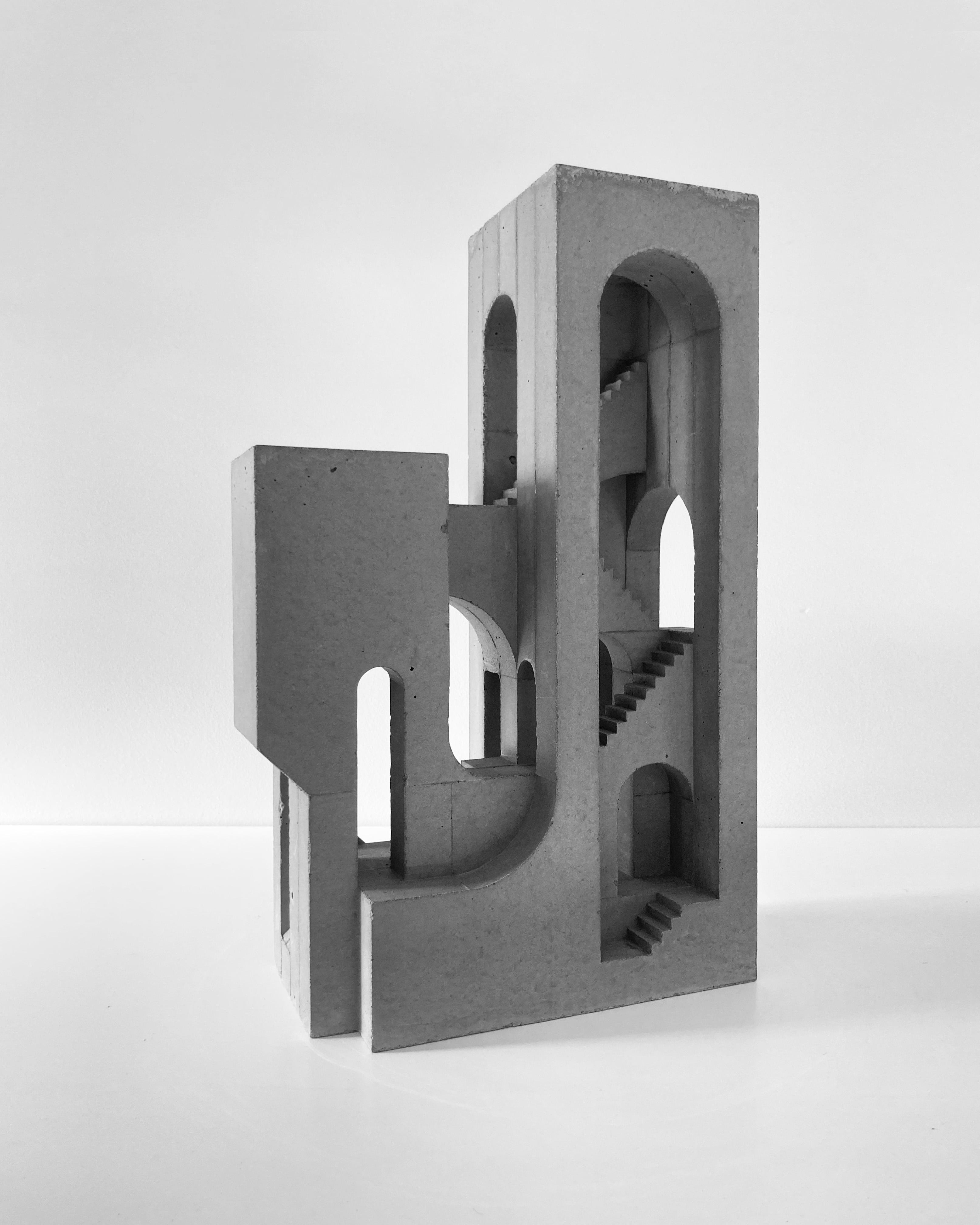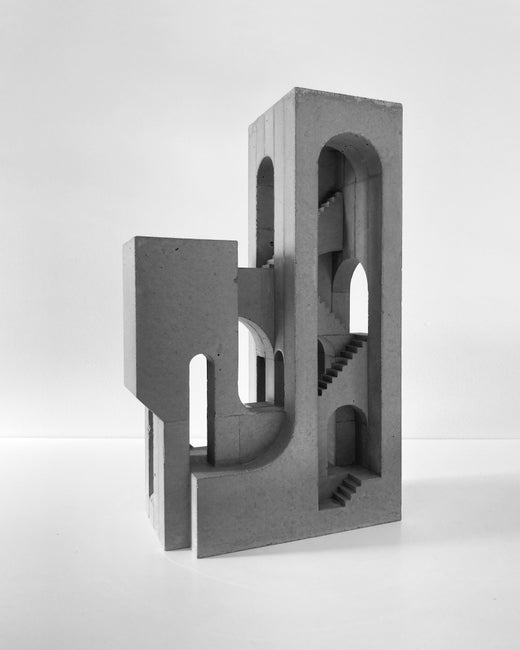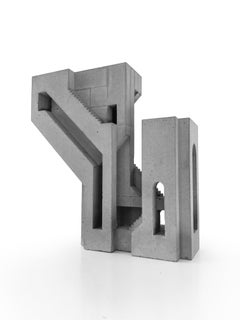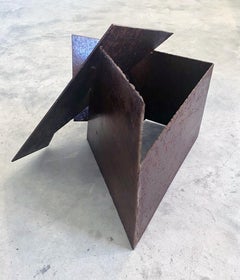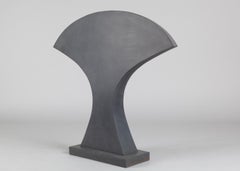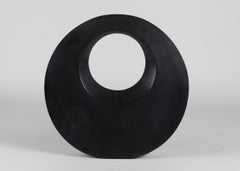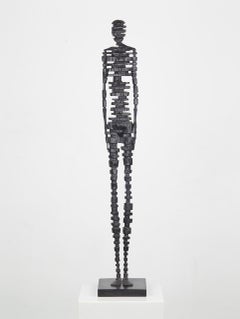Items Similar to Citadel No.2 Concrete Sculpture, Contemporary, Unframed, 18x17 in
Want more images or videos?
Request additional images or videos from the seller
1 of 5
David UmemotoCitadel No.2 Concrete Sculpture, Contemporary, Unframed, 18x17 in2024
2024
$2,750
£2,076.98
€2,399.24
CA$3,874.36
A$4,149.44
CHF 2,230.71
MX$50,397.36
NOK 28,186.11
SEK 25,806.48
DKK 17,926.71
About the Item
David Umemoto transforms concrete structures into fantastical worlds by reinterpreting recognizable architectural forms. Staircases, archways, corridors, and ramps are miniaturized, inverted, flipped, and compiled into unfamiliar and labyrinthic arrangements. While the resulting sculptures are imposing and monumental, due to their solid concrete composition, they are also open and airy, inviting viewers to visually traverse them.
Beginning from a 2-dimensional drawing with a definitive vantage point, Umemoto constructs 3-dimensional spaces that can be accessed and discovered from multiple possible angles. Our relationship with the sculptures becomes altered as we explore the purposely placed openings, closed flat surfaces, and unintentional yet expected cracks and bubbles. Umemoto strategically creates his works by hand, from cutting the polystyrene casts to pouring in the mixed concrete. Every step of the process is intentionally manual and thus rooted in a rejection of technology. He aims instead to celebrate the accessibility of creating art by using economical and readily available tools and materials.
Umemoto’s works reflect directly on the act of human intervention by bridging his artistic practices with the complex patterns that are biologically produced in the wild. Initially inspired by the rock formations in American deserts, Umemoto has remained interested in the algorithms appearing in nature. He contradicts the mechanical characteristics of architecture by experimenting with plant-based, vegetal forms. In one sculpture we see a series of stairs, walls, and windows extend out from the centre structure in branches. While remaining architecturally coded, Umemoto reimagines these configurations in calculated and organic ways.
In Interconnections, there is a particular emphasis on this idea of transformation. Some of the sculptures are casted in multiple pieces and compiled in the gallery space, serving both pragmatic and ideological purposes. These components can either exist as their own sculptures – in dialogue with their counterparts – or, be balanced together in larger compositions. Embracing the possibility of multiple arrangements, Umemoto’s sculptures compel us to contemplate the notion of scale. While they are at once sturdy and grounded, some also appear as if they could seemingly topple over. These ideas of fluidity and change, conveyed in solid concrete forms, force us to challenge our perception of the permanence of the world around us.
Umemoto’s art has long reflected the ephemerality of human-made interjections existing within nature. Déambulatoire X, for instance, showcases large, open archways and stairs that appear rusticated and eroded. While this piece was the accidental result of the concrete mix not filling the entirety of the mold, he welcomes the error as a pivotal part – or transformative possibility – of his artistic practice. Like an ancient ruin decayed and fragmented, his work reflects the passing of time and the impact of natural elements on human infrastructure.
- Creator:David Umemoto (1975, Canadian)
- Creation Year:2024
- Dimensions:Height: 18 in (45.72 cm)Width: 17 in (43.18 cm)Depth: 5 in (12.7 cm)
- Medium:
- Movement & Style:
- Period:
- Condition:
- Gallery Location:Montreal, CA
- Reference Number:1stDibs: LU47615374282
David Umemoto
The concrete works of David Umemoto stand as studies about volume. At the juncture of sculpture and architecture, these miniature pieces evoke temporary buildings or monuments standing on far-away lands. The images conveyed in the mind by these works are numerous. They refer to the archaic and the ephemeral, despite the solidity and the modernity of the medium. Appearing before our eyes are pre-Columbian rock dwellings, god statues from the Andes or Easter Island, steles deteriorated by rain, remnants of modern cities having survived a cataclysm, fragments of Babylonian cities, colonial settlements brought down to their foundations, cenotaphs abandoned in the jungle… The production of David Umemoto’s works follows a process of slow and silent transformation. The creative process seeks to imitate the cycles of nature, which are cycles of erosion and re-creation. Lines shift, change and are in a state of perpetual mutation due to the influence of time and weather. The natural architectures of geological strata and crystals stand as models: They inspire the design of the moulds in which the concrete is cast. The ductile and infinitely adaptive nature of the material enables the production of objects that are both similar and different. The development of the works is thoughtful and iterative yet it makes room for improvisation, adaptation, and spontaneous inspiration. The shapes created by Umemoto line up in sequences of combinatorial variations. Each work offers a different face but these faces all belong to the same lineage. This kinship gives a strong unity to Umemoto’s production and allows for the exploration of the theme of transformation through time and tradition. All of Umemoto’s pieces are handmade, in order to respect an economy of means. The pressure of modernity imposes on man the obligation to evolve constantly, which leads him into an endless race towards technological improvement. As an artist, Umemoto chooses to react by taking a step backwards. His manual activities result from a desire to simplify artistic practice. Aesthetics and formalism are thus combined with a commitment to plainness. Opting for a low-tech stance, the artist wants to resist the demands of progress. He creates structured and modular pieces but these never perfectly fit together, a result of their willingly imperfect mode of production. Umemoto’s art is rooted in Americanness: His varied creations take their impetus from a desire to start settlements and to colonize wild lands, where nature is always on the verge of resuming its rights. When one sees Umemoto’s architecture sculptures, one thinks of the modernist complex of Brasilia by Niemeyer, lost in the Amazonian jungle, or of the complex of Chandigarh by Le Corbusier, in the heart of India. The walls rising towards nowhere, the curves running into ceilings, and the staircases leading into the void are reminiscent of the mysterious Prisons of Piranesi. One way or another, these are always works where imagination joins forces with a contemplative discipline.
About the Seller
5.0
Vetted Professional Seller
Every seller passes strict standards for authenticity and reliability
Established in 1996
1stDibs seller since 2014
107 sales on 1stDibs
- ShippingRetrieving quote...Shipping from: Montreal, Canada
- Return Policy
More From This Seller
View AllCitadel no.4
By David Umemoto
Located in Montreal, Quebec
David Umemoto transforms concrete structures into fantastical worlds by reinterpreting recognizable architectural forms. Staircases, archways, corridors, and ramps are miniaturized, ...
Category
2010s Contemporary Figurative Sculptures
Materials
Concrete
Citadel No.1 Concrete Sculpture, Contemporary, Unframed, 18x17 in
By David Umemoto
Located in Montreal, Quebec
David Umemoto transforms concrete structures into fantastical worlds by reinterpreting recognizable architectural forms. Staircases, archways, corridors, and ramps are miniaturized, ...
Category
2010s Contemporary Figurative Sculptures
Materials
Concrete
Sacred Place
By David Umemoto
Located in Montreal, Quebec
The concrete works of David Umemoto stand as studies about volume. At the juncture of sculpture and architecture, these miniature pieces evoke temporary buildings or monuments standi...
Category
2010s Contemporary Figurative Sculptures
Materials
Concrete
Cityblock Level 1-6
By David Umemoto
Located in Montreal, Quebec
The concrete works of David Umemoto stand as studies about volume. At the juncture of sculpture and architecture, these miniature pieces evoke temporary buildings or monuments standi...
Category
2010s Contemporary Figurative Sculptures
Materials
Concrete
Untitled
By Guillaume Lachapelle
Located in Montreal, Quebec
Guillaume Lachapelle’s artistic practice is shaped predominantly by sculpture, expressed in the form of installations and detailed miniature models. Lachapelle presents playful universes which combine objects of undetermined purpose; in this way, he opens the conventions of our reality to fresh disposition. The architecture of his models – which Lachapelle has recently begun to make with the help of the latest 3-D printing technology – shows motifs originating from the everyday, certainly, but seeming strange, alienating or even uncanny when combined as the artist chooses. A kind of transition between two worlds often appears in Lachapelle’s work – for example when the model of a library filled with books curves inwards and reveals a mysterious opening pointing into darkness – these are the artist’s references to spaces and occurrences which may be concealed below the surface of outward semblance.
Guillaume Lachapelle has participated in several solo and group exhibitions including Manèges at Circa – Centre d’Exposition Art Contemporain (Montreal) in 2006; Quebec Gold at the Ancien Collège des Jésuites (Rheims, France) in 2008 and in Abracadabra (Edward Day...
Category
2010s Contemporary Abstract Sculptures
Materials
Nylon, Acrylic
Chimère
By Guillaume Lachapelle
Located in Montreal, Quebec
Guillaume Lachapelle's artistic practice is shaped predominantly by sculpture, expressed in the form of installations and detailed miniature models. Lachapelle presents playful universes which combine objects of undetermined purpose; in this way, he opens the conventions of our reality to fresh disposition. The architecture of his models - which Lachapelle has recently begun to make with the help of the latest 3-D printing technology - shows motifs originating from the everyday, certainly, but seeming strange, alienating or even uncanny when combined as the artist chooses. A kind of transition between two worlds often appears in Lachapelle's work - for example when the model of a library filled with books curves inwards and reveals a mysterious opening pointing into darkness - these are the artist's references to spaces and occurrences which may be concealed below the surface of outward semblance.
Guillaume Lachapelle has participated in several solo and group exhibitions including Manèges at Circa - Centre d'Exposition Art Contemporain (Montreal) in 2006; Quebec Gold at the Ancien Collège des Jésuites (Rheims, France) in 2008 and in Abracadabra (Edward Day...
Category
21st Century and Contemporary Post-Modern Sculptures
Materials
Nylon
You May Also Like
Citadel
By Christian Hootsell
Located in New Orleans, LA
Christian Hootsell was born in Mississippi and resides in Dallas, TX. While touring museums early in life, Hootsell became fascinated with metal sculpture and was inspired by the wo...
Category
2010s Contemporary Abstract Sculptures
Materials
Steel
Untitled (1)
By Masatoyo Kishi
Located in Columbia, MO
Masatoyo Kishi (Japanese‑American, 1924 - 2017) was an artist whose career bridged East and West, combining his early studies in physics and mathematics with a long‑standing commitme...
Category
20th Century Contemporary Abstract Sculptures
Materials
Stone
Untitled (2)
By Masatoyo Kishi
Located in Columbia, MO
Masatoyo Kishi (Japanese‑American, 1924 - 2017) was an artist whose career bridged East and West, combining his early studies in physics and mathematics with a long‑standing commitme...
Category
20th Century Contemporary Abstract Sculptures
Materials
Stone
Temple
Located in New York, NY
Johannes Nielsen (b.1979) was born in Falkenberg, Sweden. He is an artist who uses bronze sculpture to celebrate life and its beauty. He believes that sculptures of the human body ca...
Category
2010s Contemporary Figurative Sculptures
Materials
Bronze
Price Upon Request
Architectural Concrete Sculpture of Temple Remnants
Located in Bruxelles, BE
Mattia Listowski(b. 1987, Paris, France) is a French sculptor, draughtsman, and photographer with French, Italian, and Polish origins, coming from a creative family. He lives and wor...
Category
2010s Contemporary Figurative Sculptures
Materials
Concrete
Composition #8
By Toni Ross
Located in Fairfield, CT
Composition #8
Stoneware and slip
Category
2010s Contemporary Figurative Sculptures
Materials
Stoneware, Slip
Price Upon Request
